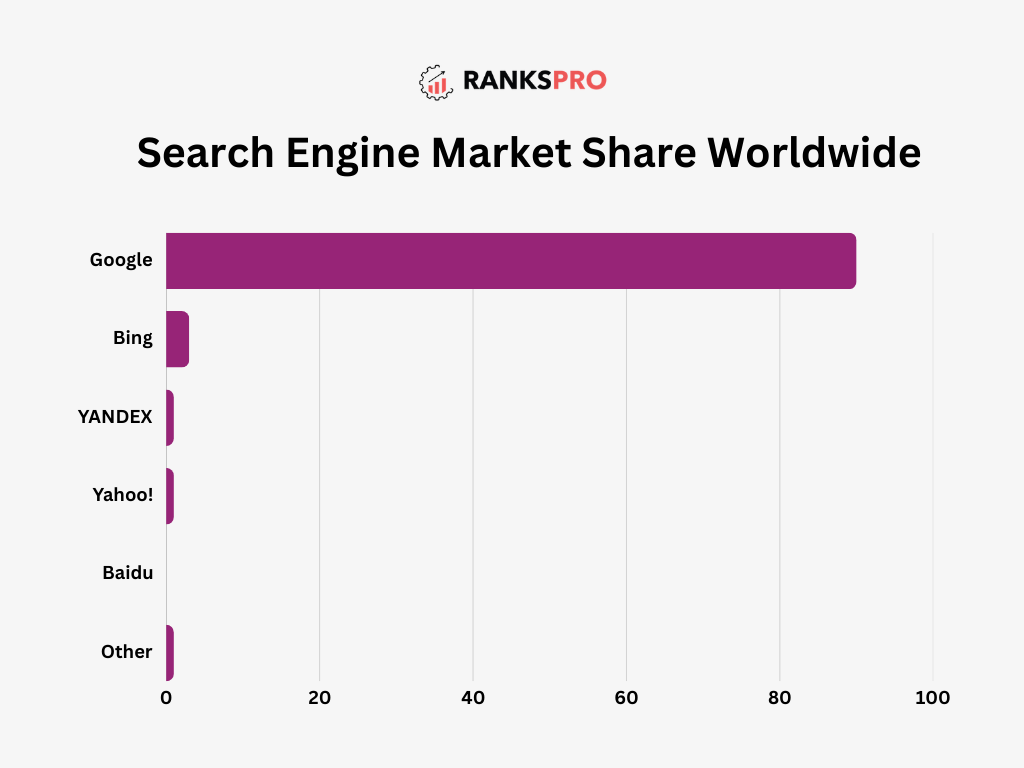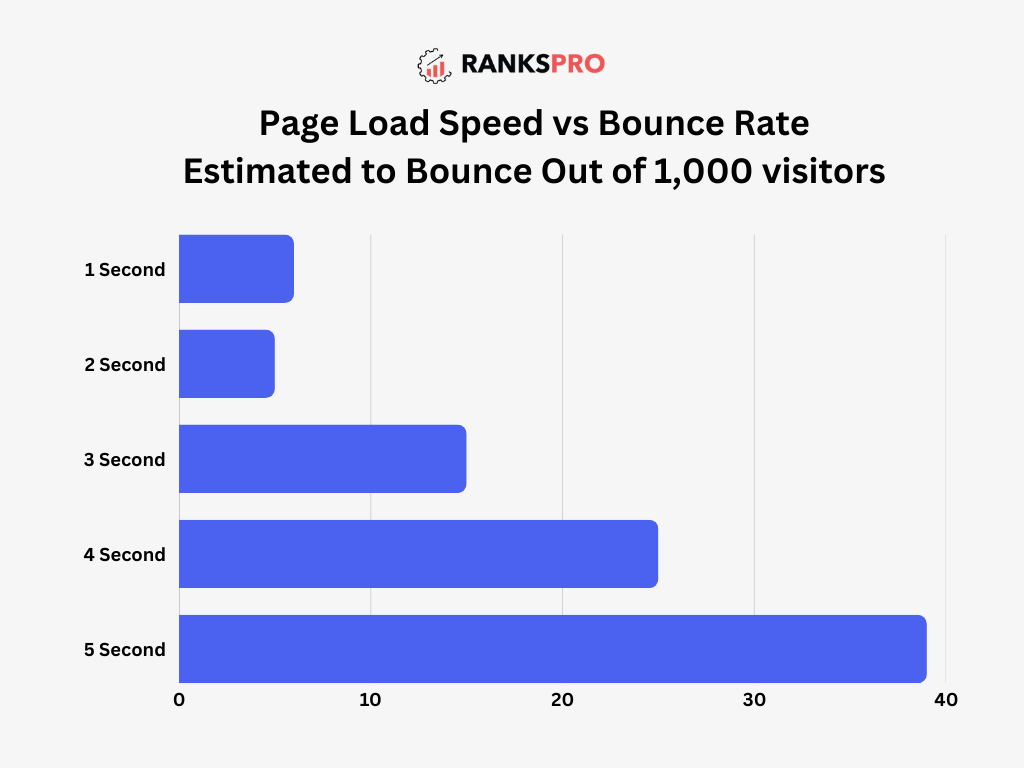As the competition in SEO world is rising every year, it has become a great challenge as well as opportunity to rank higher on Google. With advancing search algorithm updates and new technologies, businesses and marketers need to be adaptive to leverage more than 90% of web traffic from the first page of Google.
However, the question arises – how they can rank higher on Google? And how they can leverage this traffic and organic visibility! There should be a strategic approach to prefer critical ranking factors over traditional activities to gain rankings.
This guide will explain all the crucial factors and proven strategies that can drive improved search rankings on Google. It covers the updated information that can blend with the latest Google search algorithm updates that have involved AI as well.
Whether you’re a blogger, business owner, or digital marketer, these insights will help you stay ahead of the competition and achieve sustainable SEO success in 2025.
Why Aim for Higher Google Rankings?
Not just a vanity measure, a higher rank on the search results of Google is actually a catalyst for online success. Here is how:
1. Increased Visibility & Organic Traffic
The more you rank higher on Google, the more you’ll be visible to potential customers. Most of the users click on the top search results; hence higher rankings truly and directly translate into increased organic or free traffic to your site.
This organic traffic is hugely valuable, since it consists of interested seekers looking for what you have to offer; hence, it’s a source of better qualified leads.
2. Enhanced Credibility & Trust
Primarily, Google’s algorithm favors authoritative and relevant sites. Thus, being ranked high on Google signals users that your business is trusted and an authority in their field. It instantly builds credibility – leading to win users’ trust and keep them engaged with your content.
3. Improved Brand Awareness
Gaining consistent visibility on the first page of Google becomes an important aspect for establishing your brand. Even when they do not immediately click, they will hear the brand name repeatedly and get to know the offerings you provide. This results in enhanced brand recognition, making users to become potential leads for your website.

4. Higher Conversion Rates
Users discovering your website via organic search are usually go further along with the buying process. They are actively searching for answers; thus they are more likely to convert than a top of funnel visitor. Higher rankings drive more qualified traffic, and more qualified traffic drives higher conversion opportunities.
5. Cost-Effective Marketing
Achieving high rankings in Google searches, as compared to paid advertising, is a long-term cost-effective marketing strategy. SEO is inexpensive, but it guarantees sustained traffic and visibility that lead to substantial returns on investment.
6. Competitive Advantage
If you have competitors who rank higher than you, then they are likely to attract customers who would have been yours. Being ranked above your competitors on Google guarantees a bigger market share and a huge competitive advantage.
7. Long-Term Sustainable Growth
Paid advertising can fetch you quick results, but organic rankings are the foundation for sustainable growth. A well-optimized website attracts traffic and enables lead generation over time, thus establishing a consistent business source.
How Google’s Algorithm Updates Influence Ranking Factors?
With the evolving technologies and user behaviors in search results, Google is continuously updating its ranking algorithms and criteria. It focuses more on displaying the most relevant and value-driven information and resources on the top of the results.
The latest algorithmic updates influence the Google ranking factors in several ways. Let’s understand these dynamics in more depth:
1. The Nature of Google’s Algorithm Updates
- Continuous Refinement
Google not only makes significant changes, but it also continuously refines its search algorithms. This continuous evolution means, therefore, that SEO is not a “set it and forget it” activity.
These changes are continuous in nature, with minute modifications occurring daily and larger named updates meant for more consequential shifts in search behavior or quality standards.
- User-Centric Focus
The update intends to enhance user experience. These updates favor the websites that are helpful, informative, and trustworthy. Often, the updates mitigate the effects of unethical practices aimed at converting searchers into clicks to content of diminished quality.
- Understanding Core Updates
A Core Update is a broad change to Google’s ranking systems. They are not targeting a particular issue but aim to improve the general assessment for Google of content’s relevance.
These Google search algorithm updates lead to fluctuations in ranking. Hence, website owners need to pay particular attention to E-E-A-T (Experience, Expertise, Authoritativeness, and Trustworthiness) and overall content quality.
2. Ranking Updates and Their Effects
- Content Quality and Relevance
Content quality and relevance can also be seen in several updates, including Helpful Content Update and core updates. All of these updates emphasize ensuring content high quality, originality, and satisfaction towards user intent.
It means going beyond keyword stuffing and towards valuable information that answers users’ questions. Google is growing smarter and smarter over time regarding the nuances of languages and context.
- E-E-A-T (Experience, Expertise, Authoritativeness, and Trustworthiness)
Google Search Quality Rater Guidelines prioritize the adoption of E-E-A-T, and these updates tend to remain for long. This means they provide content by the expert and back it up by good, credible sources, then presenting the information with transparency.

The new addition to the acronym would be experience, meaning that the resource should have first-hand experience with a topic and heavily weighed.
- Local SEO
Local search algorithm updates are geared towards getting accurate and relevant local search. Components such as Google Business Profile optimization, local citations, and user reviews. Proximity, relevance, and prominence are the key local ranking factors for Google.
- Semantic Search and Natural Language Processing
Semantic search and natural language processing innovations enable Google to appreciate far more of the meaning behind search queries.
Updates, as such, named “BERT” and “MUM”, will now enhance Google’s interpretation of complicated queries and the relevance of the results it presents. This now implies creating content in answer to how a user intends to search.
Understanding Google’s Key Ranking Factors in 2025
The search algorithm of Google is a dynamic and complex framework that is intended to deliver search results that matter most to the user. With 2025 on the horizon, any website that wished to secure visibility on a sustainable basis must understand core ranking factors.
Here’s an in-depth look at the key elements:
1. High-Quality, Helpful Content: The Cornerstone of Success
- Focusing on User Intent
Google’s algorithms are evolving with the times. Beyond 2025, Google shall have more power than ever in terms of processing language and context in search situations.
Keyword stuffing and content farms are dead; now, if it does not genuinely serve the user and give value, it better not even be published.
E-E-A-T is now not an optional checkpoint but adhered to from the get-go; Google cares for content produced by actual experts with real-world experience and is properly sourced and transparently published.
Content must answer users’ query directly. The AI advancement has helped Google improve immensely in interpreting what sort of intent lies behind a given query.
- People-First Content
The “Helpful Content” update of Google is intended to reward content written for humans rather than for search engines. This means:
- Writing original, insightful, and informative content that responds to particular user needs.
- Avoiding writing that is primarily focused on getting a ranking for keywords.
- Optimizing for a good user experience.
Focus on providing value-driven answers to the users’ queries that can help them solve problems. Not doing so will leave your audience unsatisfied, making your content weak to rank higher on Google
- Content Formats and Multimedia Integration
It is way livelier in 2025. Content is a combination of several formats comprising:
- Well-crafted video pieces with visual explanations and demonstrations.
- Interactive content generating audiences’ interest and encouraging participation-such as quizzes, calculators, and polls.
- Podcasts and audio content that allow users to access information at their convenience.
- Visuals that are search-engine friendly.
- Content freshness and Regular updates
- Content Freshness and Regular Updates
Keeping content updated is of great importance. If you regularly update your existing content with new information, insights, and opinions, you are definitely indicating to Google that your website is a relevant and up-to-date resource.
2. Backlinks and Domain Authority: Establishing Credibility and Trust
- Quality Over Quantity
The backlinks alone have had a big say in your ranking. Today, however, it is no longer just about the number of links that you have; instead, it is more about the quality concerning the links.
For example, Google insists on sourcing backlinks from credible and relevant websites within the same industry as yours.
You would suffer drastic penalties in ranking for spammy link-building tactics, such as purchase or exchange links.
- Domain Authority and Topical Relevance
Domain authority is defined as the overall strength and credibility of your website. Backlinks from websites that are related to your niche carry much more weight.
Another important thing is topical relevance. You need to put in effort continuously to build high quality content, get authoritative backlinks and also establish strong online presence to build your domain authority.
- Digital PR and Brand Mention
Digital PR and brand mentions are central to the function of building domain authority. Not only is it important to earn mentions within reputable news and industry publications but also to achieve exposure on the blogs of influential figures in your field. Building real-world relationships with people in your industry is very important.
3. User Experience (UX) Signals: Prioritizing User Satisfaction
- Page Loading Speed and Core Web Vitals
One of the important UX factors is page loading speed and is generally measured through core web vitals. It includes Largest Contentful Paint (LCP), First Input Delay (FID), and Cumulative Layout Shift (CLS) that provide an insight into page performance.

Users expect websites to deliver content fast, with pages loading slowly resulting in higher bounce rates. Thus, optimizing these metrics ensures a smooth user experience.
- Mobile-Friendliness and Responsive Design
Since most internet users browse websites on their mobile devices, mobile-friendly is of utmost importance. Responsive design allows your website to seamlessly grow or shrink across various screens and devices.
Mobile-first indexing shows Google primarily uses the mobile version of your website for indexing and ranking purposes.
- Secure Connections (HTTPS)
HTTPS encryption will go a long way in protecting user data and building trust. Google favors sites that use HTTPS, and nowadays, it has become a must for all sites.
- Accessibility
Accessibility is becoming a huge focus for Google in terms of getting the web out to as many users as possible. Your website must therefore be usable by those with disabilities. Correct use of alt text and semantic html must be considered.
- Interactive Elements and Engagement
An equally good user experience is about engagement, in addition to speed and security. Positive user experience comes from clear navigation, intuitive design, and user-friendly interfaces.
Interactivity like quizzes, calculators, and polls gets users to stay longer on your site and engage with your content.
- Dwell time
Google looks into how long users remain on your web pages. Longer dwell times suggest that your content is engaging and helpful.
By creating an understanding these primary ranking factors and optimize strategies according to them, you can increase chances of being highly ranked on Google.
Latest Strategies to Rank Higher on Google
The very essence of SEO is changing from time to time based on Google’s algorithm updates and user behavior. A future after 2025 would best thrive through a holistic approach that lays maximum emphasis on user experience, content quality, and excellence in technology.
1. Conducting Effective Keyword Research (Beyond the Basics)
- Intent-Driven Research
Move beyond keyword volume. Understand the query intent. Because Google now understands all the nuances through its NLP tools, it now uses all useful information in the “People Also Ask” and “Related Searches” sections for long-tail keywords and related topics.
Furthermore, realize that keywords can have different implicit intents: informational, navigational, transactional, transactional-commercial investigation.
- Topic Clusters and Content Hubs
Instead of focusing on individual keywords, topic clusters now build content hubs, which will impress Google on topical authority.
Identify the critical areas that fit in your world and write pillar pages to them to optimize depth. Build supportive contributions back to that pillar page to create a cohesive, comprehensive resource.
- Leveraging AI in Keyword Research
AI-supported tools are able to read and analyze massive amounts of data to identify emerging trends and potentially catch opportunities in keywords.
Using AI, you might better grasp how keywords’ semantic features interact with one another and view other possible future keywords. You could also consider top keyword research tools, with voice search and conversational AI rising.
2. On-Page SEO Strategies to Improve Google Rankings (E-E-A-T and User Experience)
- E-E-A-T Optimization
Your site ought to express Experience, Expertise, Authoritativeness, and Trustworthiness. Author bios, supervisors, and real credentials should be visible to readers.
And information should be accurate, precise, and referenced from reputable sources. Firsthand experience is now very big. Therefore, if you write about a product or service, show some evidence that you have used it.
- User-Centric Content Optimization
The text should be optimized for readability, with engagement achieved through clear headings, subheadings, and bullet points.
Adding multimedia (images, videos, infographics) will significantly boost the user experience. Also, meta titles and descriptions should be optimized for better CTR.
- Semantic HTML and Schema Markup
Always use semantic HTML tags that will convey more context to crawler from Google. Implement schema markup that contains structured data to help Google understand the nature of your content. This could lead to rich snippets with better visibility in search results.
3. Creating High-Quality, Engaging Content
- Multimedia Content
Use video, podcasts, and other interactive content in a mix of formats. Video content is powerful in attention-getting and very good at complex information delivery. Short-form video distributions are worth considering, such as YouTube Shorts and TikTok.
- Interactive Content
By developing quizzes, calculators, and polls, the interactivity of your content can boost user engagement. Such interactivity can lure users to spend more time on your website while disseminating your content.
- Personalized Content
Make use of data and analytics in your efforts to personalize content for each user. This may involve considerations of user demographics and interests as well as user behavior.
- AI Generated Content
Google is quite capable of recognizing AI-generated content that has not been modified by a human. With the creeping prevalence of AI content, human editing and enhancement by a subject matter expert becomes all the more important.
AI can do much in assisting with content research, outlines, and drafts, but the ultimate editing must be performed by a human to ensure quality and accuracy.
4. Technical SEO Practices for Higher Google Rankings (Performance and Accessibility)
- Core Web Vitals Optimization
Continuously monitor and optimize your website’s Core Web Vitals. Using tools like Google PageSpeed Insights and Google Lighthouse can help you to identify and correct performance issues within your website.
- Mobile-First Indexing
Ensure your website is fully responsive and offers a great mobile experience. Optimize for speed and usability on the mobile site.
- Site Architecture and Crawlability
Establish an easy-to-understand and navigable site architecture, thus making it easier for Google crawlers to crawl your website.
Use XML sitemaps to direct the crawlers and make sure all significant pages are indexed. Do ensure that your robots.txt file is properly configured.
- Security (HTTPS)
Always keep the website secure with HTTPS. It encrypts user data and boosts trust in the eyes of Google.
5. Off-Page SEO Techniques to Boost Google Rankings (Building Authority)
- Earning High-Quality Backlinks
Links to your website are another important factor that will raise your potential to rank higher on Google. Focus on acquiring backlinks from authoritative and relevant websites.
Strategies such as guest blogging, content marketing, and public relations may be employed. Avoid spammy link schemes that might hurt your reputation.
- Brand Mentions and Online Reputation Management
Monitor brand mentions and interact with users on social media and other platforms. Build your online reputation by providing superior customer service and responding to negative reviews.
- Social Media Engagement
Social links do not add much in terms of ranking; however, social signals should give more exposure to the brand and drive traffic to the website. Get social with your audience relevant to your brand.
- Digital PR
Relationships with journalists and media professionals can yield newspapers and blogs targeting potential customers with high-quality backlinks and brand awareness.
6. Enhancing User Engagement Metrics (Beyond Bounce Rate)
- Dwell Time and Time on Page
Develop content that is worthy enough to hold users on the page and engage or interact with them in various ways, such as with multimedia elements, interactive content, and appropriate internal linking.
- Click-Through Rate (CTR)
Click-through rate (CTR) is one of the important SEO metrics that can help you track how good your content is in bringing potential readers and converting them into prospective leads.
- User Interaction
Further continue to invite users to share and comment. User interaction helps Google locate signals for highly helpful content with huge user interest.
7. Local SEO Strategies for Improved Local Google Rankings (Hyperlocal Focus)
- Google Business Profile Optimization
Make sure your Google Business Profile is completely and appropriately filled in. Those keywords, photos of high quality, and customer reviews need to appear.
- Local Citations
Ensure that your business details are correct and consistent among all online directories and citations. More local citations should be built on good web sources.

- Local Reviews and Ratings
Encourage customers to leave their footprints in reviews on Google and other review avenues and respond to them when time allows.
- Hyperlocal Content
Write articles, create blogs, or produce videos about local events and news that are going to make some noise in your community.
8. Adapting to Emerging SEO Trends in 2025
- AI-Powered SEO
Utilize some AI-powered SEO tools for better technical SEO expertise. Let robots play with data and identify trends and automate development tasks to offer performance benefits.
- Voice Search Optimization
Voice searches require content optimized for the natural flow of human language and long-tail keywords. The focus should be on answering these questions directly and providing succinct information.
- Visual Search
Provide optimized images for visual search with descriptive file names and alt text. Consider the creation of visual content optimized for platforms such as Google Lens.
- Personalized Search
Understand how user data and personalization directly influence search results. Build relationships with your audience, focus on personalized experiences.
Keeping the trends in sight and continuously customizing your strategies will help to get better rankings on Google and sustain growth for your business.
Track Google Rankings for Improvements with RanksPro’s Rank Tracker
In the dynamic world of SEO, knowing where you stand is crucial. Without accurate tracking, you’re navigating in the dark, unable to measure the effectiveness of your efforts or identify areas for improvement. That’s where RanksPro’s Rank Tracker comes in.

Here are the ways to leverage this rank tracker:
- Precise and Reliable Tracking
RanksPro’s Rank Tracker provides accurate and up-to-date data on your website’s Google rankings. Monitor your performance across specific keywords, locations, and devices, giving you a comprehensive view of your search visibility.
- Identify Trends and Opportunities
Track your ranking history over time to identify trends and patterns. Spot opportunities for improvement by analyzing keyword performance and identifying areas where you’re losing ground. Find what keywords are trending up, and capitalize on that.
- Competitor Analysis
Keep a close eye on your competitors’ rankings and identify their SEO strategies. Discover keywords they’re targeting and analyze their content to stay ahead of the curve. See where your competitors are outranking you, and find out why.
- Local and Global Tracking
Whether you’re targeting a local audience or a global market, RanksPro’s Rank Tracker allows you to monitor your rankings in specific locations. Gain valuable insights into your local SEO performance and optimize your strategy accordingly.
- Detailed Reporting and Analysis
Generate comprehensive reports that provide detailed insights into your ranking performance with easy to understand graphs, and data visualization. Analyze your data to identify areas for improvement and track the effectiveness of your SEO campaigns.
- Proactive Optimization
By monitoring your rankings regularly, you can proactively identify and address any issues that may be affecting your search visibility. Make data-driven decisions to optimize your website and improve your rankings.
With RanksPro’s Rank Tracker, you’ll have the insights you need to climb the Google rankings and achieve your SEO goals.




